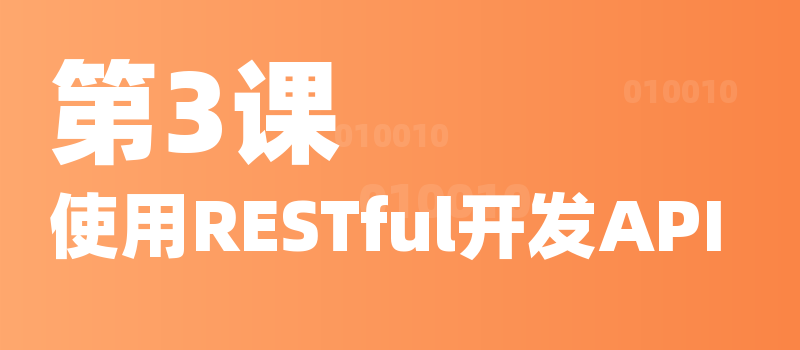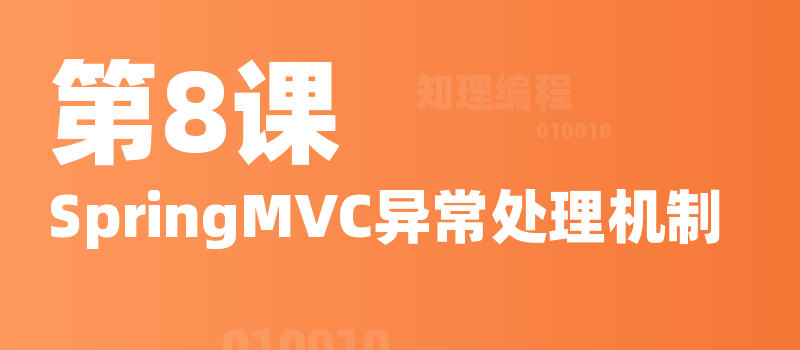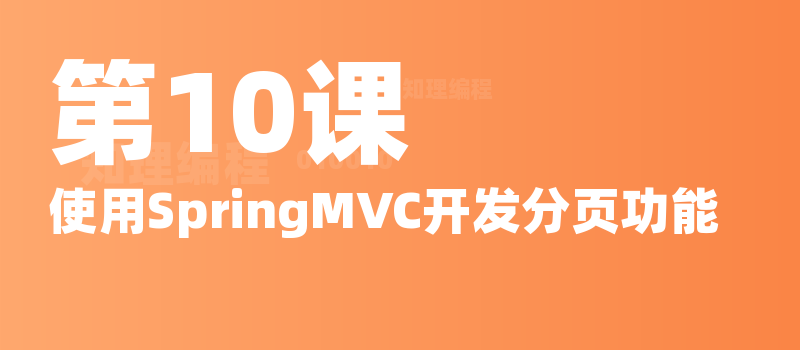第3课_使用RESTful开发API
热度🔥:65 免费课程
授课语音
掌握使用SpringMVC遵循RESTful开发规范的API设计
SpringMVC是Spring框架的一部分,它为开发者提供了灵活和强大的Web应用程序开发支持。在RESTful风格的API设计中,SpringMVC发挥着重要作用。RESTful是基于HTTP协议的规范,通过对资源(如数据对象)进行访问和操作,提供一致的接口和行为。
在本文中,我们将详细介绍如何使用SpringMVC遵循RESTful API设计规范,设计易于理解、可维护且高效的API。
1. RESTful API设计基础
1.1 RESTful的定义
RESTful(Representational State Transfer)是一种架构风格,它利用HTTP协议的方法(GET、POST、PUT、DELETE)来对资源进行操作。RESTful API通过URI来标识资源,操作这些资源的行为由HTTP方法来指定。
RESTful的特点:
- 无状态性(Stateless):每个请求包含了所有的必要信息,不依赖于服务器的任何状态。
- 资源的唯一标识(URI):每个资源都有一个唯一的URI,客户端通过URI访问资源。
- 标准化的操作(HTTP方法):使用标准的HTTP方法(GET、POST、PUT、DELETE)来进行操作。
- 返回标准化格式:通常返回JSON或XML格式的数据。
1.2 RESTful API的基本原则
- 使用HTTP方法表示操作:
GET:获取资源。POST:创建资源。PUT:更新资源。DELETE:删除资源。
- 资源表示:资源应该通过URI来标识,并且通过HTTP请求和响应来进行操作。
- 无状态性:每个请求都应该是独立的,不依赖于任何以前的请求。
2. SpringMVC中使用RESTful API设计
2.1 SpringMVC Controller设计
SpringMVC提供了方便的注解方式来实现RESTful风格的API。@RestController是一个组合注解,等同于@Controller和@ResponseBody,用于简化RESTful API的开发。
示例:使用@RestController实现基本的RESTful API
import org.springframework.web.bind.annotation.*;
@RestController // 声明为RestController,所有返回值都会被自动转化为JSON
@RequestMapping("/api/v1/products") // 设置基本URL前缀
public class ProductController {
// GET 请求:获取所有产品
@GetMapping
public List<Product> getAllProducts() {
return productService.getAllProducts();
}
// GET 请求:获取单个产品
@GetMapping("/{id}")
public Product getProduct(@PathVariable Long id) {
return productService.getProductById(id);
}
// POST 请求:创建新产品
@PostMapping
public Product createProduct(@RequestBody Product product) {
return productService.createProduct(product);
}
// PUT 请求:更新产品
@PutMapping("/{id}")
public Product updateProduct(@PathVariable Long id, @RequestBody Product product) {
return productService.updateProduct(id, product);
}
// DELETE 请求:删除产品
@DeleteMapping("/{id}")
public void deleteProduct(@PathVariable Long id) {
productService.deleteProduct(id);
}
}
@RestController:表示该类是一个RESTful API的控制器。@RequestMapping("/api/v1/products"):为所有请求路径定义公共前缀,表示所有的API路径都以/api/v1/products开头。@GetMapping、@PostMapping、@PutMapping、@DeleteMapping:分别表示处理GET、POST、PUT和DELETE请求。@PathVariable:用于获取路径中的参数。@RequestBody:将请求体中的JSON数据转换为Java对象。
2.2 URI设计原则
遵循RESTful风格时,设计资源的URI时要遵循一些基本规则:
- 使用名词而非动词,表示资源。
- 使用复数形式表示资源集合。
- 通过嵌套URI表示资源之间的层次关系。
- 避免使用不必要的查询参数。
示例:RESTful URI设计
- 获取所有产品:
GET /api/v1/products - 获取单个产品:
GET /api/v1/products/{id} - 创建新产品:
POST /api/v1/products - 更新产品:
PUT /api/v1/products/{id} - 删除产品:
DELETE /api/v1/products/{id}
2.3 SpringMVC的自动响应JSON
SpringMVC的@RestController会自动将Java对象转换为JSON格式的响应,无需显式地指定@ResponseBody。Spring根据请求的Accept头部自动选择合适的响应格式。
示例:返回JSON格式的数据
import org.springframework.web.bind.annotation.GetMapping;
import org.springframework.web.bind.annotation.RestController;
@RestController
public class ProductController {
@GetMapping("/api/v1/products")
public Product getProduct() {
Product product = new Product(1L, "Product1", 100.0);
return product; // 自动转换为JSON
}
}
返回的JSON格式:
{
"id": 1,
"name": "Product1",
"price": 100.0
}
3. SpringMVC RESTful API设计最佳实践
3.1 统一的响应格式
为了确保API返回的一致性,可以设计统一的响应格式,包含状态码、提示信息和数据。
示例:统一的响应格式
public class ApiResponse<T> {
private int code;
private String message;
private T data;
// 构造器、getter、setter略
}
修改ProductController中的方法,使得返回统一格式的响应:
@GetMapping("/api/v1/products")
public ApiResponse<List<Product>> getAllProducts() {
List<Product> products = productService.getAllProducts();
return new ApiResponse<>(200, "成功", products);
}
返回格式:
{
"code": 200,
"message": "成功",
"data": [
{
"id": 1,
"name": "Product1",
"price": 100.0
}
]
}
3.2 错误处理
SpringMVC可以通过@ExceptionHandler来处理API中的异常,确保返回一致的错误响应。
示例:全局异常处理
import org.springframework.http.HttpStatus;
import org.springframework.web.bind.annotation.ExceptionHandler;
import org.springframework.web.bind.annotation.ResponseStatus;
import org.springframework.web.bind.annotation.RestControllerAdvice;
@RestControllerAdvice
public class GlobalExceptionHandler {
@ExceptionHandler(ProductNotFoundException.class)
@ResponseStatus(HttpStatus.NOT_FOUND)
public ApiResponse<String> handleProductNotFoundException(ProductNotFoundException ex) {
return new ApiResponse<>(404, ex.getMessage(), null);
}
}
@RestControllerAdvice:定义全局的异常处理器。@ExceptionHandler:处理特定的异常类型。@ResponseStatus:设置HTTP状态码。
3.3 版本管理
为了兼容不同版本的API,可以通过路径、请求头或参数来进行版本控制。
示例:路径版本控制
@RestController
@RequestMapping("/api/v1/products")
public class ProductController {
// v1版本的API
}
@RestController
@RequestMapping("/api/v2/products")
public class ProductControllerV2 {
// v2版本的API
}
示例:请求头版本控制
@RequestMapping(value = "/products", headers = "API-Version=1")
public List<Product> getV1Products() {
// 处理v1版本的请求
}
@RequestMapping(value = "/products", headers = "API-Version=2")
public List<Product> getV2Products() {
// 处理v2版本的请求
}
4. 总结
- RESTful API设计原则:使用HTTP方法(GET、POST、PUT、DELETE)操作资源,资源通过URI唯一标识,采用无状态性设计。
- SpringMVC的支持:通过
@RestController、@GetMapping、@PostMapping等注解,SpringMVC使得RESTful风格的API开发变得简单。 - URI设计:设计合理的URI路径,确保清晰表达资源的层次结构。
- 统一响应格式:设计统一的响应格式,提升API的可维护性和一致性。
- 错误处理与版本管理:使用全局异常处理和版本控制策略,保证API的健壮性和可扩展性。
通过遵循RESTful的开发规范和SpringMVC的强大支持,可以开发出清晰、易于维护且高效的API。












